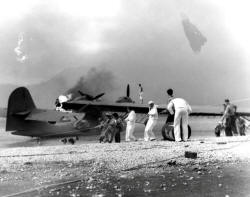|
 Shock,
aftermath of Pearl Harbor attack laid out at U.S. museum Shock,
aftermath of Pearl Harbor attack laid out at U.S. museum
 Send a link to a friend
Send a link to a friend
[December 06, 2016]
By Scott Malone
NATICK, Mass. (Reuters) - A
telegram telling of the attack on Pearl Harbor and a
West Point cadet's letter afterwards seeking advice from
his father, General Dwight Eisenhower, are among
exhibits at a U.S. museum illustrating the shock and
horror that catapulted the United States into World War
Two.
|
|
 The attack on the U.S. naval base in Hawaii on Dec. 7, 1941,
75 years ago on Wednesday, shook a country that had been so
focused on the war in Europe that it had lost sight of the
threat posed by Japan, said Kenneth Rendell, director of the
Museum of World War Two, outside Boston. The attack on the U.S. naval base in Hawaii on Dec. 7, 1941,
75 years ago on Wednesday, shook a country that had been so
focused on the war in Europe that it had lost sight of the
threat posed by Japan, said Kenneth Rendell, director of the
Museum of World War Two, outside Boston.
"The whole issue was America not getting into the war in Europe,
and part of the reason this attack was so shocking was because
everyone was so focused on Europe," said Rendell, a dealer in
historic documents who founded the museum in 1999 to house a
collection that holds some 500,000 items related to the war.
One never-before-exhibited piece is a letter that West Point
Cadet John Eisenhower sent to his father, then-Brigadier General
Dwight Eisenhower, the night of the attack after learning that
he and his classmates would be graduating early and deploying.

"It seems impossible that the Japs have the audacity to attack
us as far east as Hawaii," the letter read. "What can I do to
develop myself?"
The attack, launched to destroy the U.S. Pacific fleet and with
the aim of keeping the United States out of the war, took 2,390
American lives.
The exhibit shows relics directly from the attack including
pieces of downed Japanese planes and the binoculars that had
been used on the bridge of the battleship the USS Arizona, which
was sunk in the attack.
It also shows the backlash against people of Japanese descent
living in the United States.
[to top of second column] |

That side of the war story is told through items including a pin
claiming to be a "Jap Hunting License"; an official poster ordering
residents of the Los Angeles area who were of Japanese ancestry to
register; and a painting by an inmate from an internment camp for
Japanese-Americans.
Rendell said he hoped the exhibit illustrated the complexities of a
war that is often romanticized in Hollywood movies and television
documentaries.
"I think people are yearning for a connection with a time when they
believed the country was united," he said during a tour of the
museum in Natick, Massachusetts, about 20 miles west of Boston. "I
want them to come out of this with an appreciation of the complexity
and intensity of this period."
In addition to its extensive collection of documents, the museum's
collection includes a U.S. Sherman tank, dozens of uniforms and six
of the "Enigma" machines that Germany used for coded transmissions.
Rendell said the museum is in the midst of a fund-raising campaign,
aiming to replace its current 10,000 square foot facility, which can
display just a fraction of its collection, with a new 65,000 square
foot museum.
(Reporting by Scott Malone; editing by Grant McCool)
[© 2016 Thomson Reuters. All rights
reserved.] Copyright 2016 Reuters. All rights reserved. This material may not be published,
broadcast, rewritten or redistributed.

|